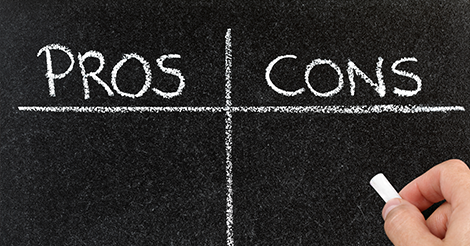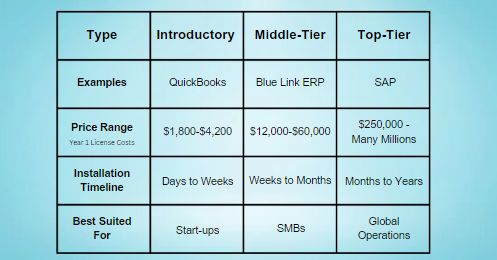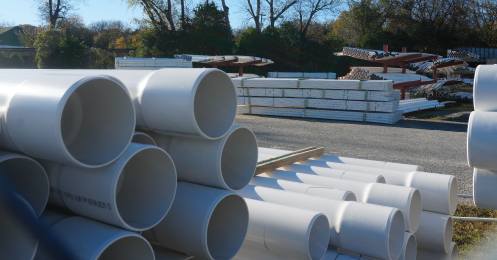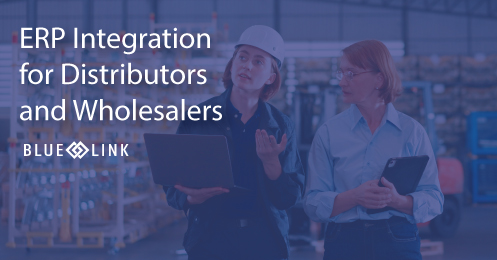Enterprise Resource Planning software (ERP) packages are complex systems that accommodate a variety of business functions across departments such as accounting, inventory, order processing, purchasing, contact management, warehouse management and customer communication. Although most ERP systems will provide similar functionality, due to the complex nature of sophisticated ERP, it can be difficult to compare them, especially when evaluating more than 2-3 potential vendors.
Aside from basic inventory and accounting functionality, ERP systems also include features geared towards specific industries and you will find that there are different types of ERP depending on whether or not your business is in manufacturing, wholesale distribution or service. To help you find the fight solution, the following are several ways you can compare ERP software offerings:
- Software Tier
- Deployment Method
- The People
- The Price
- Meeting Needs
- Company History
Software Tier
First and foremost, it is important that the systems you’re evaluating are directly comparable. Trying to compare introductory software such as QuickBooks to true ERP can become extremely dangerous, as the systems are designed to fulfill different needs and are appropriate for companies of different sizes and sophistication. Make sure you fully understand the different Tiers of Software available in the market to first determine which is appropriate for your business.
Introductory systems are geared towards small businesses as the first solution implemented in an organization. They are typically designed to accommodate one business process (such as accounting or inventory management) and will often require integration with other standalone systems to provide functionality across multiple departments.
To be considered true ERP software, the system will be able to accommodate a variety of business processes across the organization. ERP replaces all standalone solutions as an all-in-one system. Not all vendors abide by the same definition of ERP as it is technically defined rather loosely.
However, there are certain features inherent in true ERP solutions:
- ERP systems share a database
- Information flows between different areas of the software - accounting, inventory, sales orders etc.
- Information is available in real-time
- The system and installation is elaborate
Stop Comparing ERP to Introductory Software
Deployment Method
The deployment method you choose for your business will have an on-going impact on costs and necessary resources. For smaller businesses, cloud-based solutions tend to be the better option.
On the other hand, larger businesses can often benefit from on-premises software if they already have a dedicated team of IT personnel in-house, and the required server infrastructure.
In recent years, cloud-computer has taken over corporate and personal data. Think of your Netflix information – it’s stored on the cloud. They rely on the cloud for its scalability and storage needs, similarly to an ERP software vendor.
A mid-sized distribution business considering cloud-based solutions will benefit from off-site server maintenance managed by the vendor.
Do your research to determine which method is best for your business, and make sure that you compare the total costs of ownership between the two over a span of several years. A vendor that provides both options gives you the flexibility to switch down the road as your business changes.
The People Behind the Software
Many ERP systems are similar in their functionality unless they are designed for a specific industry such as pharmaceutical distribution software. Where most systems tend to differ more greatly, is in the people behind the software.
Evaluate your experience with the people behind the company to get a feel for how you think it will be to work with them in the future. This includes sales staff, consultants, developers and support personnel. The easiest way to do this is to start by evaluating the person you work with during initial sales discussions.
Ask yourself these questions:
Are they attentive to your needs?
Are they personal and put your business needs first?
Do they understand your industry?
Do they ask the hard questions and sometimes say “no”?
ERP is designed to grow with your business and so it is important that you're happy with the people behind the software for when it comes to dealing with after-sale support, customization projects and upgrades. Ask the vendor to speak with existing customers to get a feel for their experience
The Price
Another obvious, but dangerous, means of comparison is the price. Certainly, the price is very important in making a decision but always be careful. Low costs may be attractive but could also be the result of low-ball figures or an initial discount, which means you might end up paying more down the road.
High costs are usually a safer bet in terms of functionality and conservatism, but you may be paying more than you need to. ERP solutions within the same tier will have comparable price points so instead, the art is finding a balance between low and high and understanding what the appropriate price is based on the market.
Some vendors will offer a Year 1 License Discount to attract new customers but remember that the original quoted price will be reflected the next year with potential hidden costs and continue until the contract is broken. The software chosen is a company investment and the decision to purchase should not be taken lightly. Don’t be afraid to ask questions and consider if a short-term discount is worth it in the long term.
Keep in mind the price is not just about what you pay for software, but also the cost savings you will gain from having a system that can automate processes and increase efficiency.
Meeting Your Needs (Customization and Software Fit)
Software flexibility is a great way to compare. Some vendors offer a “canned” piece of software that is rigid and cannot easily be adapted to your specific business. This is commonly found in introductory software. No two businesses are exactly alike and so it is important to find a system that is able to adapt to your unique needs.
However, implementing a completely customized solution is also not the best approach. Ultimately you want a balance of both built-in functionalities specific to your business and industry, and flexibility through customization.
We were just thinking about what it was like with our old system compared to Blue Link. UUUUGGGHHHHHH-shudder at the thought. Hammer and Chisel are gone! You guys have made our lives so much better! All of the little tweaks that are left are so inconsequential it is funny (needed, but minor issues)! Thank you for helping me/us look forward to work!
Marcel Potter, Wiseworth Canada
Company History and Current Standing
Look at a company’s history to determine viability. The longer they have been around the better – keeping in mind that ERP software has only been around since 1990.
Also, bigger is not always better as large companies have been known to dump software products fairly frequently, forcing upgrades or software upheavals. Instead, look at the company’s success stories (case studies), testimonials, determine the frequency of updates and be sure that the company is constantly adding to the system instead of winding it down. And better yet – talk to its customers.
In summary, the best way to compare ERP software is to review the following:
(1) software tier
(2) deployment method - cloud vs. on-premises
(3) the sales team, consultants, support staff, developers and management of each solution
(4) the cost
(5) the ability to customize the system, and (6) each software vendors company history and current standing - is the software in question still being developed and updated?











